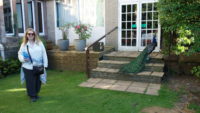 One of the recurring joys of travel is when we encounter something unexpected and unplanned. The regular sights we visit are almost always worth going to see, but the unexpected moments of beauty or humor or kindness are always special.
One of the recurring joys of travel is when we encounter something unexpected and unplanned. The regular sights we visit are almost always worth going to see, but the unexpected moments of beauty or humor or kindness are always special.
After breakfast in a cafe by by the Dee River, we set out, first stopping at the very nearby Abbey Farm. You might think it’s a farm with an abbey on site, but you’d miss out on the genius of having an RV and camping park with an abbey on site. An abbey that is locked and inaccessible except (as it turns out, which I learned when I looked it up) by booking a guided tour online. We still walked around the perimeter and saw the abbey from two very good angles. Mer, who was in charge, decided that this was enough for a bonus sight on the way to the town of Ruthin.
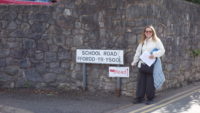 We drove on the shockingly good road over the Horseshoe Pass and along a very winding road to Ruthin, a town of 5500 people. For such a small town, Meredith had a long day of touring set up for us, starting with Ruthin Gaol (jail). Ruthin Gaol was a prison from about 1650 to about 1915, with a new Victorian wing added in the 1860s. That wing now forms the museum of the jail, which has been restored to the Victorian model after having been town offices (after 1915) and a munitions factory (during WW II). This is the third Victorian prison Meredith and I have seen, after seeing Dublin’s on earlier trips and the Lincoln Castle prison just the other day. While not ever wanting to be in prison, I’ve been impressed at the amount of light and air these prisons had in them. In the case of Ruthin, the cells each only held one prisoner, as they were designed. Dublin and Lincoln were made that way but gave way to overcrowding as more prison space was needed.
We drove on the shockingly good road over the Horseshoe Pass and along a very winding road to Ruthin, a town of 5500 people. For such a small town, Meredith had a long day of touring set up for us, starting with Ruthin Gaol (jail). Ruthin Gaol was a prison from about 1650 to about 1915, with a new Victorian wing added in the 1860s. That wing now forms the museum of the jail, which has been restored to the Victorian model after having been town offices (after 1915) and a munitions factory (during WW II). This is the third Victorian prison Meredith and I have seen, after seeing Dublin’s on earlier trips and the Lincoln Castle prison just the other day. While not ever wanting to be in prison, I’ve been impressed at the amount of light and air these prisons had in them. In the case of Ruthin, the cells each only held one prisoner, as they were designed. Dublin and Lincoln were made that way but gave way to overcrowding as more prison space was needed.
Ruthin had very strict rules about keeping clean and keeping the prison clean. Prisoners were given a bath once a week, and cells had to be swept every morning and washed one or two times a week depending on the season. Long-term prisoners got more and better food so that they would stay healthy and be available for work. Work could be walking on the prison treadmill to pump water up into the water tower, working in the kitchen, breaking rocks up for use in roads, or doing pointless tasks like turning a handle that simply ran a counter, which was used as a punishment.
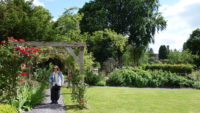 Prisoners were forced to exercise in the yard one hour a day, during which they had to walk around in silence, each holding on to a common rope to keep space between each other. They wore caps with masks to they would have a hard time talking, and those who did talk were punished by losing food for the day. The thought behind having a silent prison was to punish the wrongdoers, and to give them space to contemplate what they had done and drive them to God. The silent-prison approach was abandoned in the late 1800s.
Prisoners were forced to exercise in the yard one hour a day, during which they had to walk around in silence, each holding on to a common rope to keep space between each other. They wore caps with masks to they would have a hard time talking, and those who did talk were punished by losing food for the day. The thought behind having a silent prison was to punish the wrongdoers, and to give them space to contemplate what they had done and drive them to God. The silent-prison approach was abandoned in the late 1800s.
The museum had good interactive activities in the cells for kids, from finding various bears that were locked up to having kids plan an escape. It was very clever.
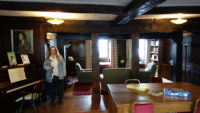 After the jail, we hiked back up to the town center to go tour the oldest known timber house in Wales, having been lived in continuously from 1435 to 1984. The house has been restored, but the genius of this house, which I have never seen before, is that it’s been restored to seven different eras in the home’s use. The original hall is restored to the 1940s, and there are rooms set up from the 1400s, the early 1600s, the late 1600s, the 1700s, the late 1800s, and the early 1900s. It was a great way to see the changing times and a reminder of how many people lived in the home.
After the jail, we hiked back up to the town center to go tour the oldest known timber house in Wales, having been lived in continuously from 1435 to 1984. The house has been restored, but the genius of this house, which I have never seen before, is that it’s been restored to seven different eras in the home’s use. The original hall is restored to the 1940s, and there are rooms set up from the 1400s, the early 1600s, the late 1600s, the 1700s, the late 1800s, and the early 1900s. It was a great way to see the changing times and a reminder of how many people lived in the home.
The back of the house contains a pretty garden, both a formal manicured garden and a nut-tree garden that is fairly wild. We explored both the house and the garden and enjoyed the time there.
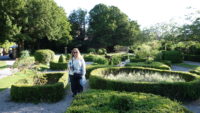 From the house, we went down from the town center to a craft/arts center, where we looked an exhibit on a woman who makes somewhat abstract clay sculptures of animals, looking to tap into the “truth of the animal.” I can’t say I loved her work (the faces of the animals tended to be fairly grotesque), but the work was thought-provoking.
From the house, we went down from the town center to a craft/arts center, where we looked an exhibit on a woman who makes somewhat abstract clay sculptures of animals, looking to tap into the “truth of the animal.” I can’t say I loved her work (the faces of the animals tended to be fairly grotesque), but the work was thought-provoking.
We grabbed a free “art in the streets” map from the center and spent about an hour wandering town looking for “spy holes” (like peepholes) that let you see 3-D photos or creations of artist renderings of things inspired by Ruthin. Since the holes were subtle, it took some work, but we managed to find them all. We rewarded ourselves with supper.
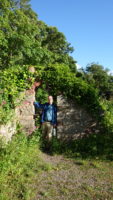 We finished supper about 7:00, which put Mer in a bit of a bind. She felt it was too early to go back home, but too late to do the hike she had been planning. I reminded her that the only major thing we hadn’t seen in town was the grounds of the castle, so we headed there to see if they were open. They were, since the castle is now a hotel, so we poked around the free grounds.
We finished supper about 7:00, which put Mer in a bit of a bind. She felt it was too early to go back home, but too late to do the hike she had been planning. I reminded her that the only major thing we hadn’t seen in town was the grounds of the castle, so we headed there to see if they were open. They were, since the castle is now a hotel, so we poked around the free grounds.
The castle is a newer one from the 1800s which sits on top of and is surrounded by ruins from a much older castle from the 1200s. It was fun to explore the ruins, but the real joy came when we stumbled on the colony of peacocks. We had heard their distinctive cries, but were pleased to find at least four peacocks and three peahens. It seems it is mating season, so the males were doing their best to impress the ladies with a full display of plumage. The peacocks weren’t afraid of us, so we grabbed chairs and watched them for twenty or thirty minutes.
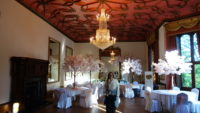 We walked around to the front of the hotel, and I decided to try my luck to see at least the lobby. The receptionists were very nice and not only said we could look around, but took us through another room into a huge room set up for a wedding fair tomorrow. The ceilings were ornate, and there was a huge chandelier, along with mirrors reflecting lights. The sign for the hotel had advertised “fairytale weddings,” and the staff members were doing their best to back that up.
We walked around to the front of the hotel, and I decided to try my luck to see at least the lobby. The receptionists were very nice and not only said we could look around, but took us through another room into a huge room set up for a wedding fair tomorrow. The ceilings were ornate, and there was a huge chandelier, along with mirrors reflecting lights. The sign for the hotel had advertised “fairytale weddings,” and the staff members were doing their best to back that up.
We were pleased enough with the castle that we decided to get dessert there, so we ate in a small but elegant room. It was a mellow way to extend our time there.
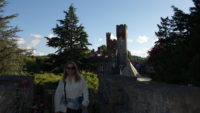 On the way back to the car, we got one last unexpected joyous moment. As we passed the open-air seating of where we’d had supper, we heard a couple of women singing “Happy Birthday,” but in the Welsh language. It was great both knowing what they were singing but having no idea what they were singing.
On the way back to the car, we got one last unexpected joyous moment. As we passed the open-air seating of where we’d had supper, we heard a couple of women singing “Happy Birthday,” but in the Welsh language. It was great both knowing what they were singing but having no idea what they were singing.
That was our day, and with a drive back over the pass, we got back home for the evening. Tomorrow we’re off to Cardiff, where I hope to make many happy memories, planned or not.